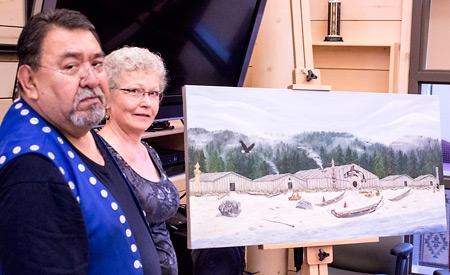A recently completed painting of the village at Tla’amin (Sliammon) First Nation was placed on display during a ceremony at Tla’amin Community Health Centre. Missing from the picture are all the houses and buildings that currently stand, replaced with longhouses, eagles and carved canoes.
The work, commissioned by Tla’amin Elder Philip George, is what the village might have looked like before contact between European settlers and West Coast first nations in the mid-1800s.
A small group gathered on September 24 at the centre to listen to the painting’s owner George and the painting’s creators artist Vi Isaac and researcher Anne-Rachel Bérubé talk about how the painting came to be.
The project was started in November 2011 after George visited Bérubé’s home and saw a painting of an eagle perched on a tree branch on a stormy day. Bérubé’s father, a Montreal-based painter, had completed the work and George told her about how it reminded him of his idea for a painting of Tla’amin.
“We wanted it to be as historically accurate as possible,” said Bérubé.
They contacted Powell River Historical Museum and Archives Association and conducted online research looking for images that may have shown what the village looked like.
“But we couldn’t find any sketches or pictures of how Tla’amin or Tees-Kwat [Townsite] could or would have looked like before contact,” she added.
George said he was assured by archeologists that the Tla’amin community, like other coastal first nations, were originally longhouse people and that they had a historical settlement at the location of the current village.
Without historical pictures to go on, they decided to create a composite picture, that included Coast Salish-style longhouses, photographs of the current landscape from the beach and carvings of welcome and totem poles.
“We took pictures of Sliammon, totem poles and types of longhouses and sent them to her father,” said George.
Bérubé said her father was initially interested in the project but later, because of health issues, had to change his mind.
George found Isaac, a Powell River-based landscape and floral painter, at Arts Alive in the Park at Willingdon Beach in the summer of 2012 where he had been singing as a member of the Tla’amin traditional singers.
Isaac started on the project by taking the collection of photographs and began sketching out what the painting would look like on paper.
“I could only go on the photos I had and what I thought it would look like,” said Isaac.
Once the concept was approved, Isaac started painting the commissioned work. It took the artist about eight months to finish the two-foot by four-foot piece.
The painting shows the village from the water with five longhouses and the main one open for what could be a potlatch ceremony, she said. It includes the mountains behind the village, canoes, eagles, welcome poles on each side and the two large boulders on the beach.
George said he is pleased with how the painting has turned out and is dedicating the work to his parents who were committed members of the Tla’amin community.



